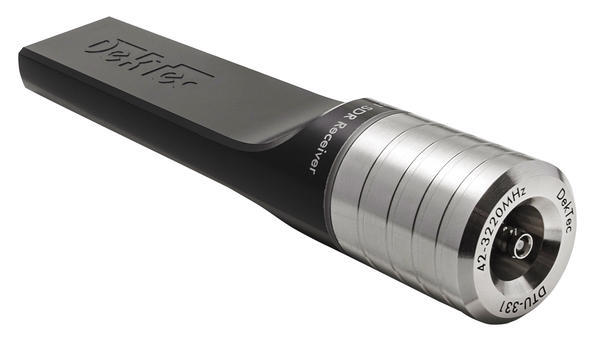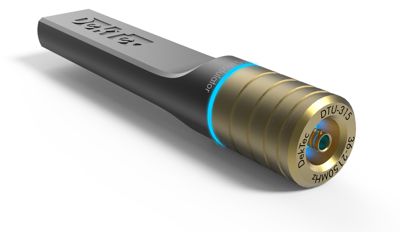
|
DTU-331 All-Standard 0-3GHz RF Probe for USB-3 Pocket sized SDR receiver ideal for on the go measurements of cable, terrestrial and satellite signals. A dual tuner approach allows fully agile tuning across 42 to 3220MHz.
|
Key Characteristics
| RF frequency | VHF, UHF, L- and S-band (42 .. 3220MHz) |
| Bandwidth |
0.85MHz (DVB-CID) 1.7, 5, 6, 7 & 8MHz (Terrestrial) 9 .. 60MHz (Satellite) |
| Sensitivity | -90 .. -20dBm |
| MER | 10 .. 42dB (measurement range) |
| Sample rate |
1 .. 80Msps Max. 40Msps when using 8Mhz tuner |
Inputs and Outputs
| RF in | 75-Ω micro-BNC female |
| USB | USB 3.2 Gen 1, Type-C Also called SuperSpeed USB |
| Power | USB powered No separate power supply required |
Modulation Standards
| Included with base product |
Reception of: ATSC 1.0 ATSC 3.0 DAB(+) DVB-C(2) DVB-CID DVB-S DVB-T DVB-T2 v1.3.1 ISDB-T/Tsb J.83 annex A/B/C Features: I/Q sample capturing T2MI output |
| Options |
-XPRT enables: Atsc3Xpert T2Xpert C2Xpert DTAPI RF measurements |
PC Support
| Windows |
10, 11; Server 19, 22, 25 Not supported under Linux yet. |
| CPU | Core i7-4xxx or above Or AMD equivalent |
Software
| StreamXpert | Our industry-standard transport-stream analyzer |
| VF-REC | SDI/TS recorder with looping, scheduling and more |
| Atsc3Xpert | Analysis of ATSC-3 with advanced RF measurements |
| C2Xpert | Analysis of DVB-C2 with advanced RF measurements |
| T2Xpert | Analysis of DVB-T2 with advanced RF measurements |
| DekTec SDKs | Create your own application |
Pricing
| DTU-331-SX | € | 3.250 | No stock |
| All-standard 0-3GHz RF probe for USB-3 with StreamXpert analyzer software. | |||
| DTU-331-XPRT-SX | € | 5.153 | No stock |
| All-standard 0-3GHz RF probe for USB-3 with Atsc3Xpert, C2Xpert, T2Xpert and StreamXpert analyzer software. | |||
Prices exclude applicable sales tax, shipping charges and customs duties. Quantity discounts may be available, please request a quotation.
Features
- Dual tuners with I/Q demodulation, A-to-D and sample-rate conversion optimized for SDR technology, enabling reception of VHF/UHF and L-band signals.
- SDR technology enables reception of entire channels, outputting all DVB-T2 services in T2-MI and forwarding ATSC 3.0 packets to IP.
- Free SDK (DTAPI) provides access to demodulated streams and advanced RF measurements.
Applications
- Measurement receiver for ATSC (3.0), DAB+, DVB-C(2), DVB-T(2), DVB-S, ISDB-T and QAM-A/B/C with unique capability to capture/analyze the full stream and advanced RF measurements.
- I/Q front-end for SDR experiments.
- I/Q sample recorder; Impulse response measurements for terrestrial networks.
Block Diagram
The DTU-331 is an all-band, all-standard SDR receiver based on a dual tuner architecture. A satellite tuner with a 9..60MHz bandwidth enables reception of DVB-S signals, while a second tuner with a bandwidth up to 8MHz adds support for terrestrial and cable standards. A front-end, with an optional RF mixer in the path, allows down-mixing of terrestrial/cable signals located in the L-band before being fed to the 8MHz tuner. The same RF mixer can also be used to downmix satellite signals in the S-band back to the L-band frequencies, so that they can be received with the 60MHz tuner.
The output of the tuners is converted to 16-bit IQ-samples with Analog-to-Digital converters and passed through a low-pass filter and a sample rate converter, which helps to clean up and prepare the signal for processing. At this stage, the IQ samples can be demodulated with the SDR demodulation software in the DekTec SDK (DTAPI) or alternatively, they could be recorded to disk or read into your own SDR application.
What is Software Defined Radio?
SDR, or software-defined radio, is a technology that allows a radio receiver to be reconfigured through software rather than requiring physical changes to its hardware. This makes SDR receivers, such as the DTU-331 and DTA-2131B, highly versatile and adaptable to a wide range of applications. For a more detailed description about SDR please refer to the following Wikipedia page.
Related Products
 |
DTU-315 – All-Standard 0-2GHz Modulator for USB-3 The DTU-315 is a USB-3 modulator counterpart for the DTU-331. Buy a set to have the ultimate portable RF test signal tool-set for use in the lab or in the field. |
 |
DTA-2131B – Multi-Standard Cable/Terrestrial Receiver for PCIe The DTA-2131B is a multi-standard VHF/UHF receiver for PCI express utilizing SDR technology. Basically, a PCIe equivalent of the DTU-331, but more suited for static lab or monitoring setups. |